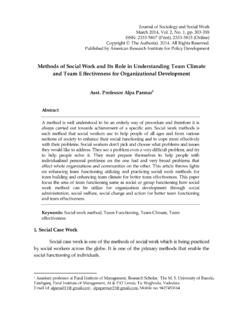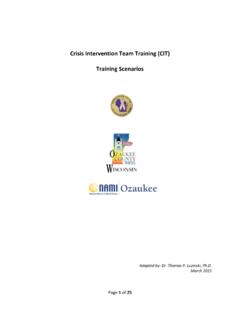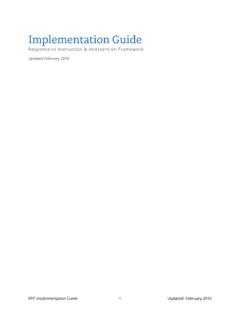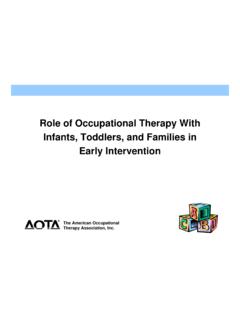Transcription of Developing an Effective Behavior Intervention Plan
1 1 Developing an Effective Behavior Intervention Plan Sec. 10. (a) "Behavioral Intervention plan means a plan agreed upon by the CCC and incorporated into a student's IEP that describes the following: (1) The pattern of Behavior that impedes the student's learning or the learning of others. (2) The purpose or function of the Behavior as identified in a functional behavioral assessment. (3) The positive interventions and supports, and other strategies, to: (A) address the Behavior ; and (B) maximize consistency of implementation across people and settings in which the student is involved. (4) If applicable, the skills that will be taught and monitored in an effort to change a specific pattern of Behavior of the student.
2 The behavioral Intervention plan seeks to maximize consistency of implementation across people and settings in which the student is involved. (b) The IEP can serve as the behavioral Intervention plan as long as the documentation the parent receives meets all the requirements in this section. 511 IAC 7-32-10 "Behavioral Intervention Plan" defined 2 Developing a Behavior Intervention Plan is a two-part planning process undertaken by a team when a student has a Behavior that impedes his or her learning or that of others. The process includes conducting a functional Behavior assessment and Developing Behavior interventions based upon that assessment.
3 The result is a framework for teaching and learning of skills which includes changes to the environment that will support the development of the new skills. PENT website, Positive Environments, Network of Trainers The Functional Behavior Assessment .. Identifies the relationship between a particular Behavior , the context in which it occurs and what the Behavior achieves for the student. Before completing an FBA, the team may first consider changes to the student s environment or writing a Behavior goal. When the process goes beyond reviewing a student s existing data and becomes collection of new information, parent permission is required.
4 A functional Behavior assessment may be considered a reevaluation. After gathering data across environments about the student s Behavior and analyzing this new information, the Case Conference Committee/Behavioral team develops a hypothesis of the function of the Behavior . This hypothesis statement becomes the starting point of the Behavior Intervention plan. A functional assessment examines antecedents to the problem Behavior and the consequences that occur following the Behavior . A hypothesis is then formed about what outcome the student gains by using this problem Behavior . It is imperative that the team designing a Behavior plan carefully develop the hypothesis about the function of Behavior .
5 The plan will both teach a replacement Behavior that meets the same function and will specify environmental alterations that remove the need for the student to use this problem Behavior to get his/her needs met. PENT website, Positive Environments, Network of Trainers 3 INSTRUCTIONS FOR COMPLETING THE FUNCTIONAL Behavior ASSESSMENT The Functional Behavior Assessment (FBA) is designed to be a tool to help guide the educator through the process of Developing a clear understanding of the function of problem behaviors. The process of the FBA helps to identify the functional relationship between a particular Behavior , the context in which it occurs, and what the Behavior achieves for the student.
6 The information collected in the (FBA) is used in Developing the student s Behavior Intervention Plan. Reason for Assessment Identified Behavior of concern, Revision of existing FBA, Discipline, Initial eligibility requirement team Members List all team members including both names and positions. Overview of Behavior Concerns The next step in the process of functional assessment is to label and describe the behaviors of concerns. Identify up to 3 behaviors, described in measureable, observable and objective terms. Be as specific as possible. 1. Avoid using adjectives: Sue is spacey and distractible.
7 2. Use action verbs to specifically describe what is happening: Sue stares out the window, wanders around the room, and plays with objects in her desk. (Examples: yells, cries, throws, kicks, hits, tears paper, moves around the room, puts head down, stares, stops talking, stops working, etc.) 3. Include descriptions of body language: faces directly, turns away, walks away, tense/stiff, etc. Eye contact: increased, decreased, focus on peers, focus on adults, stares, etc. 4. If the problem Behavior includes verbal responses, be specific in describing vocabulary, volume, intensity, to whom the words are directed, etc.
8 Examples include but are not limited to: Aggression (Physical / Verbal) Away from desk at inappropriate times Destruction of property (Vandalism) 4 Disrespect/defiance of authority Disruption of class Homework, incomplete Inappropriate interactions with others Inappropriate sexual behaviors Language, inappropriate Leaving assigned area without permission Loss of self-control Lying Mood changes, extreme Noises, inappropriate Non-compliant Off-task (included specifics what does it look like?) Pouts, whines, sulks Refuses to follow adult instruction Refuses to follow school rules Refuses to participate Self-inflicted harm/injury Sexual harassment of others Sleeping Stealing Talking, excessive Tardies, chronic Threats of aggression/harm to others Truancy Include the frequency, intensity and duration of the problem behaviors.
9 This information should be supported via direct observation and data collection. 5 Internal Setting Events / Perceptions Factors List information gathered from student reinforcer inventories used. List any medications the student is currently taking along with its intended purpose, changes in prescribed dosages and any observed changes in student s Behavior . Assessment Tools Check off all assessment tools used in the FBA process. Possible Explanations: ABC s of Problem Behaviors To answer these questions, review the information gathered from the assessment tools used.
10 Important considerations for the Antecedents: 1) Specific situations that trigger the Behavior : types of interactions, types of instruction, location, events, activities, environmental factors, etc. When: Time of day ( ) Beginning/end of the day Before/after meds Before/after/during lunch Before/after/during recess Transitions Where: Playground Hallway Cafeteria Bus Specific classrooms Outside of direct supervision Specials (art, music, PE) Office With Whom: In the presence of particular adults In presence of particular peers Number of people present 6 Types of Interactions.







